Buzzzz, kerrr, buzzzz….
I was woken up from my midnight slumber after a difficult day of field work by a buzzzz followed by kerrr… I jumped out of my bed, picked up my torch and shone about the room – floor, walls and the tiled roof too. I saw nothing. I switched off the torch went back to bed lying awake. Was I imagining this sound? Or was it a sound that I heard when I was deep in my reverie? The buzz and kerrrr recurred. My eyes searched for the source with the help of my torch yet again. I drew a blank. The weariness got the better of me and I fell asleep again.
This incident is a recollection from about three decades ago when I was staying near Yercaud town in connection with a short study of the Indian Tree Shrew Anathana ellioti supported by WWF-India. An estate worker’s quarter near Yercaud town was to be my home for the duration of the study. The room itself had just a cot for furniture, a gas stove and a couple of utensils qualifying for a kitchen.
The following morning, when there was daylight, my eyes wandered, hoping to find the source of the sound that had woken me up in the night. Nothing. I soon forgot about the sound and went outdoors for my fieldwork. I returned at lunch and was sitting on the porch drinking coffee before setting out for the afternoon session of fieldwork. My eyes wandered around and soon I noticed that the floor of the porch was splattered with plenty of yellow spots. This left me wondering. I knew this wasn’t my doing, nor did I have turmeric in the kitchen.
The silence was broken by a loud BUZZZZZ… that tapered off to gentle hum… a kirr kik kirr… before dying out. I looked around to locate the source of the sound and drew a blank again. Then, suddenly a loud buzz approached me and before I could realize it went past me. At the same time, I also noticed a big black bee fly past my field of view. I was not sure as to where it came from and where it went. I finished my coffee and left.
The following day, the same routine followed. This time, I heard a distant buzz and quickly scanned the horizon and spotted the bee as it flew in my direction. Needless to say, the buzz grew louder as the bee approached me. My eyes followed it as it flew above me towards the tile roof. It quickly entered a hole in the wooden rafter that supported the tiles.
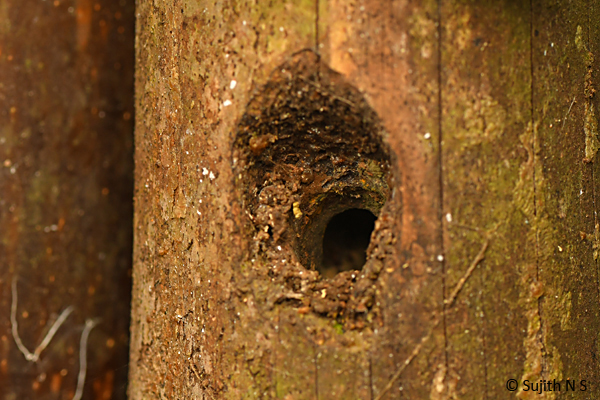
A typical hole drilled by a Carpenter Bee.
And a buzz… a kirr kik kirr and then, silence. Mystery solved! A Carpenter Bee Xylocopa sp. I also had the chance to see a similar sized bee but with a bright yellow thorax in the vicinity at times. However, I wasn’t lucky enough to capture this one on film. For that matter, I have not managed to do it to date. I learnt much later that the individual with the yellow thorax is a male and the one lacking the yellow is a female!
All this happened during the very early part of my stay at Yercaud. This also meant that I had sleepless nights on several occasions due to the buzzing sounds made by the Carpenter Bee at very odd times and that included the night time too. I had no choice but to live with it.
As the afternoon routine of sitting on the porch having coffee continued, I noticed that the bee started using a dry twig as a perch regularly and I was fascinated at the iridescent colours on the wings. One day I managed to photograph it too (those days, I still used positive film to document natural history!). The metallic colours were truly splendid indeed.
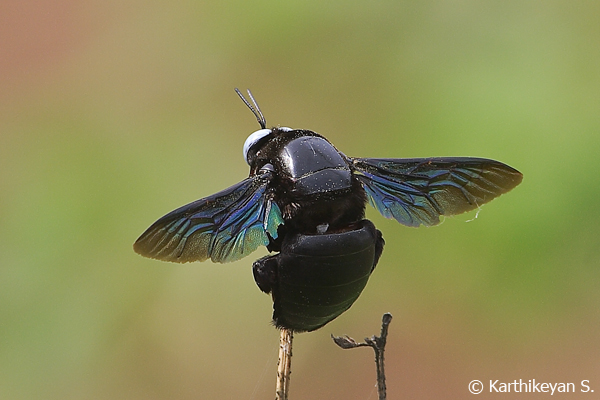
The metallic colours on the wing of a Carpenter Bee – Xylocopa sp.
These metallic colours, I learnt, is due to the structure of the wing and not due to pigments. In the process, I learnt that this kind of colour can be seen among several other insects too – beetles, bugs, wasps, butterflies for instance. And, it is not restricted to insects alone but organisms like birds too.
Over the years, I have noticed Carpenter bees use dead wood (rafters being one!) and bamboo to drill holes that will become their nests.
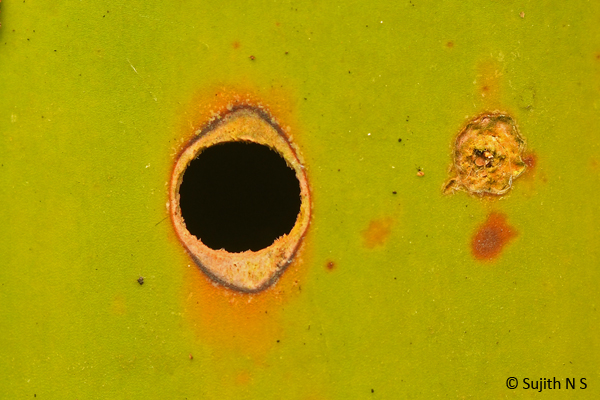
A neat hole drilled by a Carpenter Bee. It is almost difficult to believe that it is made by an insect!
This led me to think of the importance of dead trees. Besides a plethora of organisms, dead trees are also a great place for Carpenter bees! This is evident from the neat round holes that you can see often on dead limbs.
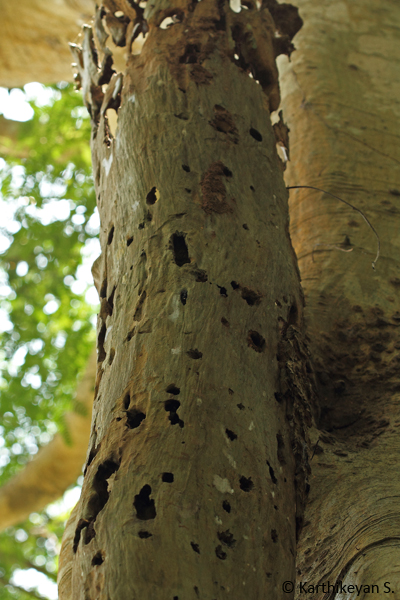
A dead limb of a tree showing a number of holes drilled by Carpenter Bees indicating the importance of dead trees in the ecosystem.
Carpenter bees, as a group, are important pollinators of several species of plants. For example, in cities, these bees can be seen visiting the beautiful flowers of the climber, Clock Vine Thunbergia grandiflora where they can be seen delving into the flower in its quest for nectar. The tree Nile Tulip Markhamia lutea is also regularly visited by Carpenter bees.
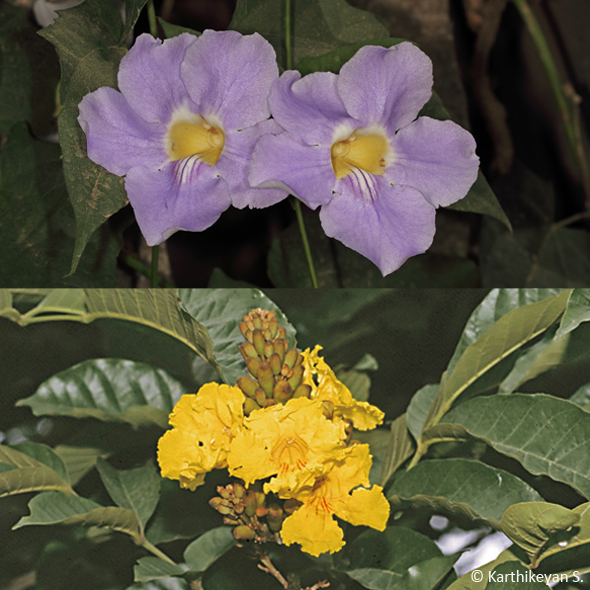
The Clock Vine (above) and the Nile Tulip (below) are regularly visited by Carpenter Bees.
They also pollinate the Giant Milkweed using a very interesting mechanism that is referred to as buzz pollination.
Recently, I happened to spot and photograph a Carpenter bee while travelling in the jungles of Uttara Kannada. I was happy as I got a chance to do so after a very long time. It cooperated enough for me to take a couple of pictures. On my return, when I was processing the images I realized that these were not the Carpenter bees that I was familiar with. Promptly, the images were sent to L.Shyamal and Yeshwant who identified them as a different species of Carpenter bee.
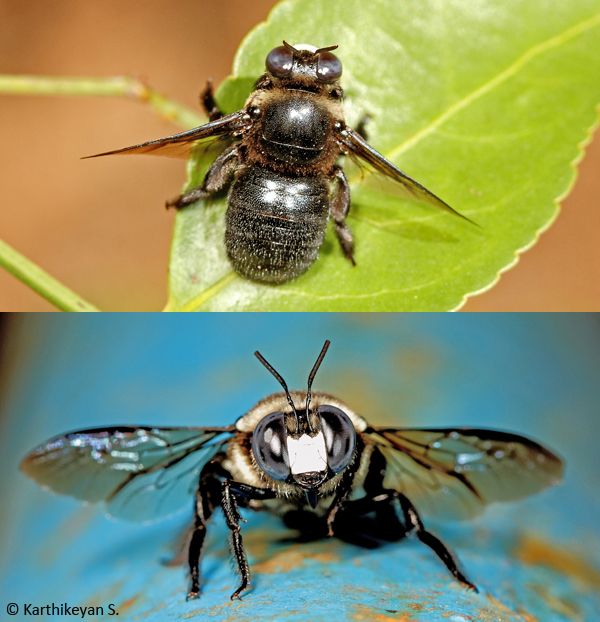
Carpenter Bee Xylocopa amethystina.
Some fact finding led me to learn that there are more than 500 species of these amazing bees. Yet again, the learning was loud and clear. Keep your eyes open so that you don’t miss the surprises that nature springs at you from time to time.